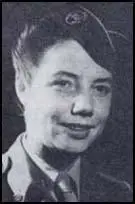Catherine Coyne

Catherine Coyne was born in Portland on 17th April, 1907. After graduating from Portland High School, Coyne entered the School of Journalism at Boston University. Coyne joined The Boston Globe in 1930. She also supplied articles for Time Magazine and Life Magazine.
In 1934 she was recruited by The Boston Herald. According to her biographer: "She wrote features that highlighted accomplishments of extraordinary New England women, provided recipes and discussed food and diet, shopping tips and fashion trends, and discussed office etiquette for working women.
In 1944 The Boston Herald sent Coyne to Europe to cover the Second World War. This included following the Allied advances after the D-Day landings in June 1944. Like fellow women journalists such as Iris Carpenter, Tania Long, and Ann Stringer, she was not made to feel welcome and they were placed under the command of the Public Relations Division and told they could not visit the front-line. This directive was later changed and along with Tania Long, Ann Stringer and Catherine Coyne she was allowed to travel with the 1st Army and reported the war in France, Holland, Belgium and Germany.
Coyne was also in Torgau when the Red Army and the US Army joined up for the first time. She wrote in The Boston Globe on 27th April, 1945: "Americans and Russians in their historic long-awaited link-up in their joint war against Germany provided the world with a hilarious preview of VE-Day in a sunny meadow on the bank of the Elbe river here this afternoon... They shook hands, posed for thousands of pictures in the center of a screaming, shoving mob of official professional and amateur cameramen, then feasted in a German barracks on captured German eggs, black bread with cheese and tumblers of champagne and eau de vivre, an inferior cognac bottled for the Wehrmacht. Primarily, however, it was a day for the little man of the armies - for the GI and the junior officer - and each made it a merry one, forgetting war while toasting the United States and Russia, swapping insignia and watches, snapping pictures and trying out one another's weapons amid noise, danger and laughter reminiscent of the Fourth of July at home."
After the war she covered the Nuremberg War Trials before writing a regular column for The Boston Globe. Catherine Coyne became engaged to Eugene A. Hudson, who she met during the Second World War while he was serving as an Army Air Force Intelligence Officer. Hudson was appointed to the Massachusetts Superior Court in 1946 and the couple married in 1949. For the next few years she was on the staff the Time-Life Bureau in Boston.
Catherine Coyne Hudson, who lived in West Harwich, died in the Mayflower Point Nursing Home in Yarmouth, Massachusetts at the age of 85, on September 25, 1992.
Primary Sources
(1) Catherine Coyne, The Boston Globe (27th April, 1945)
Americans and Russians in their historic long-awaited link-up in their joint war against Germany provided the world with a hilarious preview of VE-Day in a sunny meadow on the bank of the Elbe river here this afternoon.
There was a ceremony, of course. Maj.-Gen. E.R Reinhardt, commanding general of the 69th Infantry Division, one of whose second lieutenants made the first contact unofficially and accidentally late yesterday afternoon, crossed the Elbe in a rowboat to meet a major general of the 58th Guards Division of the Red Army.
They shook hands, posed for thousands of pictures in the center of a screaming, shoving mob of official professional and amateur cameramen, then feasted in a German barracks on captured German eggs, black bread with cheese and tumblers of champagne and eau de vivre, an inferior cognac bottled for the Wehrmacht.
Primarily, however, it was a day for the little man of the armies - for the GI and the junior officer - and each made it a merry one, forgetting war while toasting the United States and Russia, swapping insignia and watches, snapping pictures and trying out one another's weapons amid noise, danger and laughter reminiscent of the Fourth of July at home.
